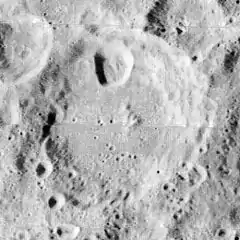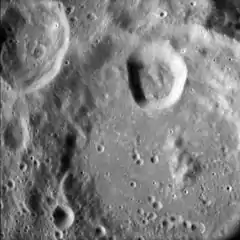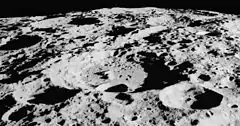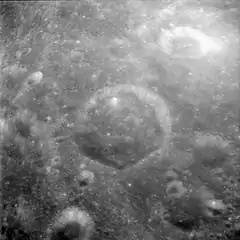Vening Meinesz (crater)
Vening Meinesz is a lunar impact crater on the far side of the Moon. The northern inner wall of this crater lies along the lunar equator. To the north of this formation is the larger crater Mandel'shtam, and slightly farther to the south is the larger Keeler. Dewar is located less than one crater diameter to the southeast of Vening Meinesz.
 Lunar Orbiter 2 image | |
| Coordinates | 0.3°S 162.6°E |
|---|---|
| Diameter | 87 km |
| Depth | Unknown |
| Colongitude | 198° at sunrise |
| Eponym | Felix A. Vening Meinesz |


This is an eroded feature with multiple small craterlets along the rim. As a result, the structure has been worn down and the rim edge is no longer well-defined. The largest of the impacts overlying this crater is a small crater along the bottom edge of the northern inner wall. The remainder of the interior floor is relatively level. Attached to the northwest outer rim is the satellite crater Vening Meinesz W, and attached along the northeast is Vening Meinesz C.
The crater was named after Dutch geophysicist and geodesist Felix A. Vening Meinesz by the IAU in 1970.[1] Vening Meinesz was known as Crater 303 prior to naming.[2]
Satellite craters

By convention these features are identified on lunar maps by placing the letter on the side of the crater midpoint that is closest to Vening Meinesz.
| Vening Meinesz |
Latitude | Longitude | Diameter |
|---|---|---|---|
| C | 1.2° N | 163.8° E | 46 km |
| Q | 2.6° S | 161.0° E | 17 km |
| T | 0.4° S | 159.3° E | 15 km |
| W | 1.5° N | 161.0° E | 39 km |
| Z | 0.8° N | 162.5° E | 25 km |
References
- Vening Meinesz, Gazetteer of Planetary Nomenclature, International Astronomical Union (IAU) Working Group for Planetary System Nomenclature (WGPSN)
- Lunar Farside Chart (LFC-1A)
- Andersson, L. E.; Whitaker, E. A. (1982). NASA Catalogue of Lunar Nomenclature. NASA RP-1097.
- Blue, Jennifer (July 25, 2007). "Gazetteer of Planetary Nomenclature". USGS. Retrieved 2007-08-05.
- Bussey, B.; Spudis, P. (2004). The Clementine Atlas of the Moon. New York: Cambridge University Press. ISBN 978-0-521-81528-4.
- Cocks, Elijah E.; Cocks, Josiah C. (1995). Who's Who on the Moon: A Biographical Dictionary of Lunar Nomenclature. Tudor Publishers. ISBN 978-0-936389-27-1.
- McDowell, Jonathan (July 15, 2007). "Lunar Nomenclature". Jonathan's Space Report. Retrieved 2007-10-24.
- Menzel, D. H.; Minnaert, M.; Levin, B.; Dollfus, A.; Bell, B. (1971). "Report on Lunar Nomenclature by the Working Group of Commission 17 of the IAU". Space Science Reviews. 12 (2): 136–186. Bibcode:1971SSRv...12..136M. doi:10.1007/BF00171763. S2CID 122125855.
- Moore, Patrick (2001). On the Moon. Sterling Publishing Co. ISBN 978-0-304-35469-6.
- Price, Fred W. (1988). The Moon Observer's Handbook. Cambridge University Press. ISBN 978-0-521-33500-3.
- Rükl, Antonín (1990). Atlas of the Moon. Kalmbach Books. ISBN 978-0-913135-17-4.
- Webb, Rev. T. W. (1962). Celestial Objects for Common Telescopes (6th revised ed.). Dover. ISBN 978-0-486-20917-3.
- Whitaker, Ewen A. (1999). Mapping and Naming the Moon. Cambridge University Press. ISBN 978-0-521-62248-6.
- Wlasuk, Peter T. (2000). Observing the Moon. Springer. ISBN 978-1-85233-193-1.